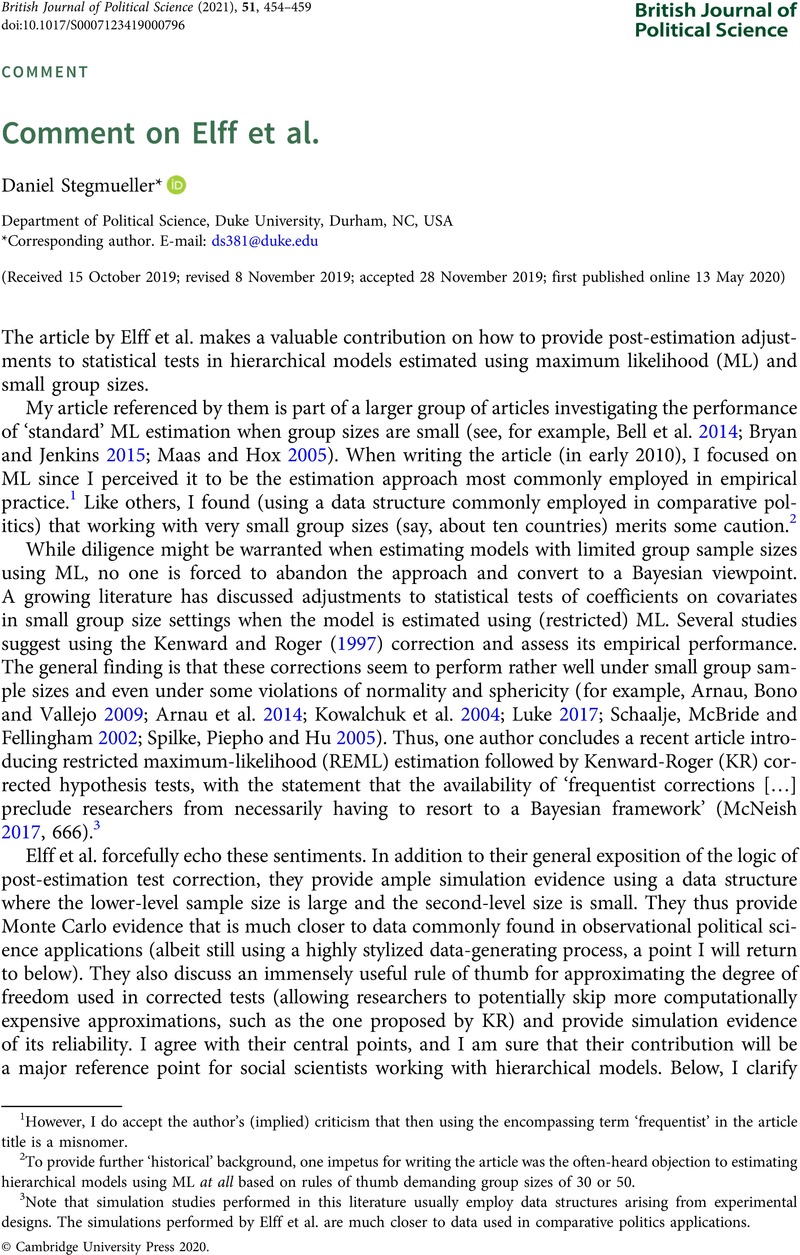No CrossRef data available.
Article contents
Comment on Elff et al.
Published online by Cambridge University Press: 13 May 2020
Abstract
An abstract is not available for this content so a preview has been provided. Please use the Get access link above for information on how to access this content.

Information
- Type
- Comment
- Information
- Copyright
- Copyright © Cambridge University Press 2020
References
Arnau, J et al. (2014) Should we rely on the Kenward–Roger approximation when using linear mixed models if the groups have different distributions? British Journal of Mathematical and Statistical Psychology 67(3), 408–429.10.1111/bmsp.12026CrossRefGoogle ScholarPubMed
Arnau, J, Bono, R and Vallejo, G (2009) Analyzing small samples of repeated measures data with the mixed-model adjusted F test. Communications in Statistics: Simulation and Computation 38(5), 1083–1103.10.1080/03610910902785746CrossRefGoogle Scholar
Bell, BA et al. (2014) How low can you go? Methodology 10(1), 1–11.10.1027/1614-2241/a000062CrossRefGoogle Scholar
Bryan, ML and Jenkins, SP (2015) Multilevel modelling of country effects: a cautionary tale. European Sociological Review 32(1), 3–22.10.1093/esr/jcv059CrossRefGoogle Scholar
Bürkner, P-C et al. (2017) Brms: an R package for Bayesian multilevel models using Stan. Journal of Statistical Software 80(1), 1–28.10.18637/jss.v080.i01CrossRefGoogle Scholar
Carpenter, B et al. (2017) Stan: a probabilistic programming language. Journal of Statistical Software 76(1), 1–32.10.18637/jss.v076.i01CrossRefGoogle Scholar
Kenward, MG and Roger, JH (1997) Small sample inference for fixed effects from restricted maximum likelihood. Biometrics 53(3), 983–997.10.2307/2533558CrossRefGoogle ScholarPubMed
Kenward, MG and Roger, JH (2009) An improved approximation to the precision of fixed effects from restricted maximum likelihood. Computational Statistics & Data Analysis 53(7), 2583–2595.10.1016/j.csda.2008.12.013CrossRefGoogle Scholar
Kowalchuk, RK et al. (2004) The analysis of repeated measurements with mixed-model adjusted F tests. Educational and Psychological Measurement 64(2), 224–242.10.1177/0013164403260196CrossRefGoogle Scholar
Luke, SG (2017) Evaluating significance in linear mixed-effects models in R. Behavior Research Methods 49(4), 1494–1502.10.3758/s13428-016-0809-yCrossRefGoogle ScholarPubMed
Maas, CJM and Hox, JJ (2005) Sufficient sample sizes for multilevel modeling. Methodology 1(3), 85–91.10.1027/1614-2241.1.3.85CrossRefGoogle Scholar
McNeish, D (2017) Small sample methods for multilevel modeling: a colloquial elucidation of REML and the Kenward-Roger correction. Multivariate Behavioral Research 52(5), 661–670.10.1080/00273171.2017.1344538CrossRefGoogle ScholarPubMed
Meng, X-L (2009) Decoding the h-likelihood. Statistical Science 24(3), 280–293.10.1214/09-STS277CCrossRefGoogle Scholar
Raudenbush, SW (1989) Centering predictors in multilevel analysis: choices and consequences. Multilevel Modelling Newsletter 1(2), 10–12.Google Scholar
Schaalje, GB, McBride, JB and Fellingham, GW (2002) Adequacy of approximations to distributions of test statistics in complex mixed linear models. Journal of Agricultural, Biological, and Environmental Statistics 7(4), 512.10.1198/108571102726CrossRefGoogle Scholar
Spilke, J, Piepho, H-P and Hu, X (2005) A simulation study on tests of hypotheses and confidence intervals for fixed effects in mixed models for blocked experiments with missing data. Journal of Agricultural, Biological, and Environmental Statistics 10(3), 374–389.10.1198/108571105X58199CrossRefGoogle Scholar
Wooldridge, JM (2010) Econometric Analysis of Cross Section and Panel Data, 2nd edn. Cambridge, MA: MIT Press.Google Scholar
Yang, Y and Land, KC (2008) Age-period-cohort analysis of repeated cross section surveys. Fixed or random effects? Sociological Methods & Research 36(3), 297–326.10.1177/0049124106292360CrossRefGoogle Scholar

